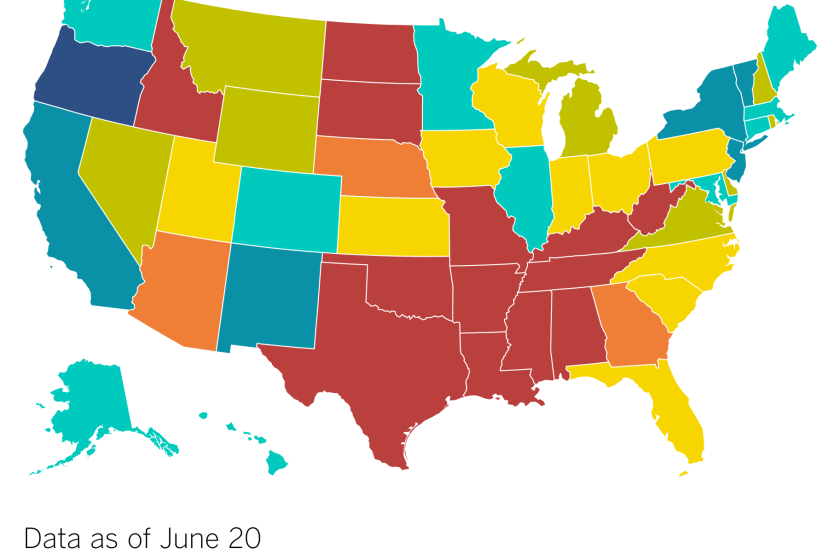Misinformation is flowing ahead of Ohio abortion vote. Some is coming from a legislative website

- Share via
COLUMBUS, Ohio — The inflammatory language targeting a reproductive rights measure on Ohio’s fall ballot is the type of messaging that is common in the closing weeks of a highly contested initiative campaign — warning of “abortion on demand” or “dismemberment of fully conscious children” if voters approve it.
Only the misleading messaging isn’t just coming from the anti-abortion groups that oppose the constitutional amendment. It’s being promoted on the official government website of the Republican-controlled Ohio Senate.
And because the source is a government website, the messaging is being prioritized in online searches for information about Issue 1, the question going before Ohio voters Nov. 7 to enshrine abortion access in the state Constitution.
The “On The Record” blog on the state Senate website is billed as an “online newsroom” presenting “the views the news excludes.” It features attacks against Ohio news outlets, op-ed style columns by Republican state senators and content generated by members of the Senate majority’s communications staff and other noted conservatives.
“Be confident that here you will find a place for facts, values, and reason,” read the announcement when Republican lawmakers launched the feature in September, shortly after Ohio voters rejected a Republican attempt to make it far more difficult to pass constitutional amendments.
Groups backing the proposed amendment say it’s an improper use of a taxpayer-supported website, while experts who study online misinformation said the effort by Republican lawmakers appeared unprecedented.
“It’s a really strategic way to make something appear to be neutral information and fact when that’s not the reality,” said Laura Manley, executive director of the Shorenstein Center on Media, Politics and Public Policy at the Harvard Kennedy School. “I’ve never seen anything like that. It’s really smart in a really devious way.”
An abortion provider accuses Beverly Hills of colluding with antiabortion activists and pressuring a landlord to block an all-trimester clinic’s opening.
In recent weeks, “On The Record” has turned its attention to denouncing Issue 1, the only statewide abortion question before voters in the November elections. Experts have said many of the claims being made are misleading or outright falsehoods about the measure, under which Ohio could regulate abortions once a fetus is viable outside the womb.
Among claims asserted in one senator’s article are that the measure would allow for “the dismemberment of fully conscious children.” Another senator’s entry repeats without context a decades-old narrative that high rates of abortion among Black women are driven by an “evil” and “predatory” abortion industry.
A featured snippet grabbed from the site that comes up during a Google search for Ohio Issue 1 says the measure “ignores Ohio’s existing exceptions for life and health of the mother in favor of establishing abortion on demand for all nine months.”
Legal and medical experts consulted by the Associated Press have called these narratives false or misleading.
The proposed amendment expressly allows Ohio to regulate abortions once a fetus is viable, as long as there are exceptions for the life or health of the woman. Ohio’s existing ban on most abortions once fetal cardiac activity is detected, now held up in court, has an exception for protecting the life of the woman as well as a more narrowly tailored health exception than Issue 1 contains. Under the existing law passed by Republicans, abortions would be allowed only when there would be “a serious risk of the substantial and irreversible impairment of a major bodily function.”
Opponents argue that Issue 1’s health exception, in particular, would allow for a virtual free-for-all for abortion doctors after viability, since the U.S. Supreme Court has defined “health” to include mental health and aspects of life that affect it. Physicians say the scenario is inconsistent with the standards they uphold for professional conduct.
Because the Ohio Senate is a government entity, supporters of the constitutional amendment worry that content posted to “On The Record” might be interpreted by voters as a source of objective information. Under Google’s search quality evaluator guidelines, government sites are generally given added weight on the grounds that they present trustworthy, verifiable, authoritative content in the interest of the common good.
“My [Republican] colleagues say that this is done because the mainstream media won’t print their stuff. But of course, the mainstream media won’t pick this up because it’s factually incorrect and basically lies,” said Democratic state Sen. Bill DeMora, whose caucus was angered by the blog and its home on the Senate’s official page.
Voters rejected a measure that would have let GOP lawmakers restrict or outlaw abortion. Can abortion rights activists replicate the win beyond Kansas?
He said Democrats are exploring whether they can launch their own version to counter the GOP.
Republican Senate President Matt Huffman shied away from labeling “On the Record” a news service when questioned by reporters shortly after its launch.
“I think it’s just the latest iteration of trying to communicate with the public,” he said.
As of Friday, the blog was the only link available under the “News” tab for the Ohio Senate. In comparison, the website for the Republican-led Ohio House features news releases on its signature bills, and awards and activities related to both Republican and Democratic lawmakers.
John Fortney, spokesman for the state Senate’s majority Republicans, said “On The Record” doesn’t cost the public anything because it’s hosted on an existing government platform and is put together by his staff.
Marjorie Dannenfelser started out as a pro-choice Republican. After changing her mind in college, she set out to outlaw abortion across the United States.
But neither his staff nor the government platform are free.
Fortney and his senior press secretary, Garth Kant, make a combined $195,000 a year, according to a database of public salaries maintained by the Buckeye Institute. The blog they spearhead is maintained by Legislative Information Services, an IT office for both of Ohio’s legislative chambers with a $13-million annual budget.
A detailed analysis of “On The Record” by a group supporting the constitutional amendment shows “no distinguishable difference” between the blog and the Senate site, meaning they use the same resources.
Britt Bischoff, chief growth officer for Red Wine & Blue, a progressive women’s organization, said the group has been trying to outcompete misinformation around Issue 1 with its own messages, but the weight given to government websites in searches makes it difficult to counter the messages spread through “On the Record.”
“While Google has been responsive in removing some results for search terms where [misinformation posts] have been flagged, it’s not 100%, and there are hundreds of search terms this page is targeting that deliberately targets questions around Issue 1 with intentional attempts to spread political ideologies in positions of authority,” Bischoff’s analysis determined.
A year after the Supreme Court overturned Roe vs. Wade, leaving abortion decisions to states, where is abortion banned or protected? What comes next?
Google did not return an email message seeking comment about its search priorities.
Fortney pushed back against the criticism. He said the op-ed style pieces are “clearly opinion,” though nowhere are they marked as such, and that “On The Record” is intended to promote the views of Senate Republicans that, in many cases, Ohio media outlets have refused to publish.
“People are free to disagree with the views expressed, but this is content that you won’t find anywhere else, certainly not in legacy media,” he said.
Mary Ruth Ziegler, a law professor at the UC Davis School of Law, said it’s common for politicians to have close relationships with advocacy organizations on either side of the abortion debate, but the Ohio Senate’s blog “crosses a line” because it’s on a government website that the public would see as providing neutral information.
“There’s a difference between delivering a campaign speech to an anti-abortion group and putting these kinds of narratives on an official government website that’s designed to inform voters,” said Ziegler, a leading historian on the abortion debate. “Your responsibilities there are different.”
More to Read
Sign up for Essential California
The most important California stories and recommendations in your inbox every morning.
You may occasionally receive promotional content from the Los Angeles Times.














